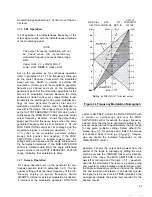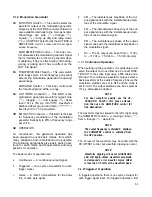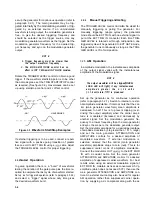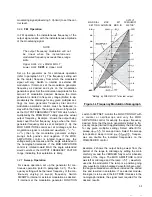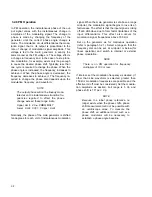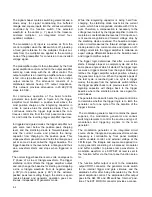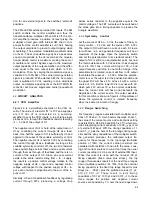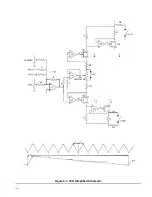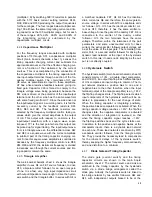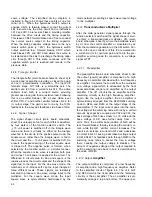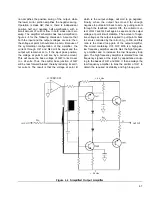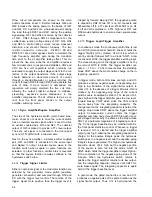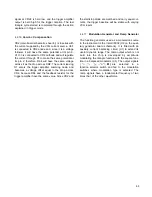
set up the generator for continuous operation (refer to
paragraph 3.2.1). The main generator may be trig-
gered internally by the modulation generator or trig-
gered by an external source. If an unmodulated
waveform is being output, the modulation generator is
free. to give the desired triggering frequency and
should be selected as the trigger source. Use any
modulation generator waveform as the trigger. Set the
modulation generator frequency for the desired trig-
ger frequency and sync on the modulation generator
output.
N O T E
1. Trigger frequency must be slower than
the output waveform frequency.
3.2.5
AM Operation
2.
The MOD AMPLITUDE control has no
In amplitude modulation, the instantaneous amplitude
effect in INT TRIG and IN T G ATE modes.
of the output signal varies with the instantaneous
amplitude of the modulation signal.
Rotate the TRIGGER LEVEL control to obtain a good
trigger. If the waveform start/stop point is to be other
than zero degrees, set the TRIG START/STOP control
as required. (See figure 3-3.) Haverwaves can be set
up using start/stop control and dc offset control.
-90°
HAVERSINES
Figure
3- 3.
Waveform Start/Stop Examples
If external triggering is to be used, connect a repeti-
tive signal with a positive going transition of greater
than one volt to EXT TRIG IN using a
cable. Adjust
the TRIGGER LEVEL control for proper triggering.
3.2. 3
Gated Operation
In gated operation there is a “burst” of waveforms
lasting the duration of the gate pulse plus the time re-
quired to complete the last cycle of waveform started.
Set up as for triggered operation (refer to paragraph 3.2.2)
and select a “trigger” signal whose duty time gives
the desired waveform burst.
3.2.4
Manual Triggering and Gating
The TRIGGER LEVEL control
can also be used
for
manually triggering or gating the generator. For
manually triggering (single cycles), the generator
mode should be EXT TRIG with no external signal in-
put at the EXT TRIG IN connector. Each time TRIG-
GER LEVEL is rotated cw through mid-position, one
triggered cycle will be generated. In EXT GATE mode,
the generator runs continuously as long as the TRIG-
GER LEVEL is CW of mid-position.
N O T E
The output waveform will be clipped(OVER-
LOAD LED will light) if any instantaneous
a m p l i t u d e g r e a t e r t h a
n 1 5 v o l t s
( 7.5 volts into
is produced.
Set up the generator as for continuous operation
(refer to paragraph 3.2.1). Switch to internal or exter-
nal amplitude modulation. If internal, note that the car-
rier (main generator waveform) mean amplitude is
decreased to half. This is to prevent clipping (over-
driving the output amplifier) when the carrier ampli-
tude is modulated (increased and decreased) by
another signal. Set the modulation generator fre-
quency to a lower frequency than the main generator
and sync the scope to the modulation generator output.
Set the modulator amplitude for a desired percentage
of amplitude modulation (0 to greater than 1 0 0 % range)
and set the main generator ATTENUATION and
AMPLITUDE controls for a desired amplitude of
modulated waveform.
If external modulation is
selected, observe that the carrier (main generator
waveform) amplitude drops to zero (null). This is for
suppressed carrier mode of amplitude modulation.
Connect the modulator OUT
to the EXT MOD
IN with a coaxial cable. Set the main generator
ATTENUATION and AMPLITUDE controls
for
a desired
amplitude of suppressed carrier waveform. For best
results when using an external modulation signal at
EXT MOD IN, maintain as near as convenient
a
5 Vp
amplitude (which does not exceed 5 VP); then use the
main generator ATTENUATION and AMPLITUDE con-
trols. An external source may also be used for regular
AM operation, rather than suppressed carrier opera-
tion, by supplying a dc component along with the ac
3-4








